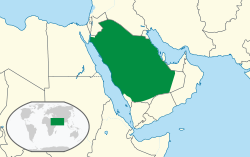Top Qs
Timeline
Chat
Perspective
Kingdom of Hejaz and Nejd
1926–1932 dual monarchy in Arabia From Wikipedia, the free encyclopedia
Remove ads
The Kingdom of Hejaz and Nejd (Arabic: مملكة الحجاز ونجد, Mamlakat al-Ḥijāz wa-Najd), initially the Kingdom of Hejaz and Sultanate of Nejd (Arabic: مملكة الحجاز وسلطنة نجد, Mamlakat al-Ḥijāz wa-Salṭanat Najd), was a dual monarchy ruled by Abdulaziz (Ibn Saud) following the Saudi conquest of Hejaz by the Sultanate of Nejd in 1925. It was the fourth iteration of the Third Saudi State.
It has been suggested that this article be merged into Third Saudi state. (Discuss) Proposed since December 2025. |
In 1932, the two kingdoms were unified as the Kingdom of Saudi Arabia.
Remove ads
History
On 8 January 1926, Abdulaziz (Ibn Saud), the Sultan of Nejd, was crowned King of the Hejaz in the Masjid al-Haram in Mecca, and he elevated Nejd to the status of a kingdom on 29 January 1927.[1] At the Treaty of Jeddah on 20 May 1927, Abdulaziz's realm was recognised by the United Kingdom of Great Britain and Northern Ireland, and was addressed as the Kingdom of Hejaz and Nejd.
For the next five years, Abdulaziz administered the two parts of his dual kingdom as separate units. On 23 September 1932, Abdulaziz proclaimed the union of the main Saudi dominions of al-Hasa, Qatif, Nejd and the Hejaz as the Kingdom of Saudi Arabia.
Remove ads
Foreign policy
The Kingdom of Hejaz and Nejd could pursue its expansionist policy with British arms supplies because of its close relations with the United Kingdom. Under King Abdulaziz, the Hejaz withdrew from the League of Nations.
In 1926, the Kingdom of Hejaz and Nejd was recognised by the Soviet Union, followed by the United States of America in 1931. By 1932, the United Kingdom, the French Third Republic, the Soviet Union, Turkey, the Imperial State of Iran, Kingdom of Italy and The Netherlands maintained legations in Jeddah; the Kingdom of Egypt maintained unofficial consular representatives.
Remove ads
See also
Notes
Sources
External links
Wikiwand - on
Seamless Wikipedia browsing. On steroids.
Remove ads

